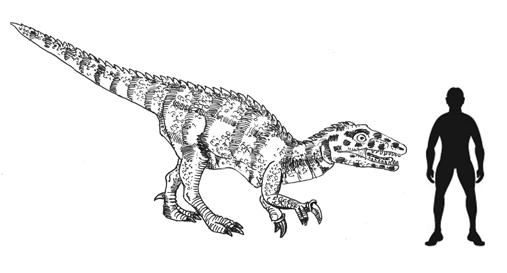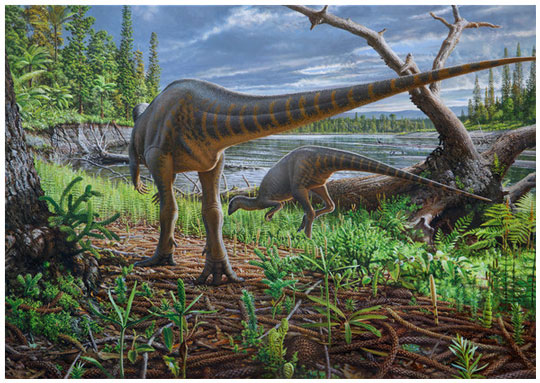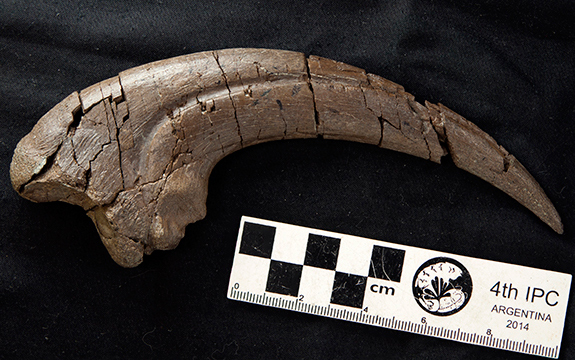Fossil Bones Unearthed in Victoria Resemble Australovenator
Scientists have announced the discovery of several isolated theropod dinosaur bones, including a vicious 20 centimetre long hand claw discovered on the Otway Coast of Victoria (Australia). The fossil material is reminiscent of Australovenator wintonensis, a megaraptorid dinosaur known from the Winton Formation of Queensland. The finding of these new meat-eating dinosaur fossils in Victoria suggests that the Megaraptoridae were both geographically and temporally widespread in Australia.
The Fossilised Hand Claw of a Megaraptorid Dinosaur
Picture credit: Stephen Poropat (Museums Victoria)
Fossils from the Eumeralla Formation
Writing in the academic “Journal of Vertebrate Paleontology”, the researchers, which included scientists from Museum Victoria, the Australian Age of Dinosaurs Natural History Museum and Swinburne University (Victoria), report the discovery of two teeth, two manual unguals, and a right astragalus that are almost identical to the corresponding elements in Australovenator.
The fossils come from the Eric the Red West (ETRW), site on Cape Otway, some fifty miles to the west of Port Phillip Bay. The strata at this location is part of the Eumeralla Formation and dates from the lower Albian of the Early Cretaceous. This suggests that the dinosaur that possessed that formidable hand claw roamed southern Australia around 107 million years ago.
In contrast, Australovenator wintonensis is known from the Winton Formation of Queensland (Cenomanian–lowermost Turonian faunal stages of the Cretaceous), as such, Australovenator roamed more than a thousand miles further north and lived at least ten million years later.
A Scale Drawing of Australovenator wintonensis

Picture credit: Everything Dinosaur
The new Victorian specimens were discovered between 2011 and 2017, by volunteers working on annual Dinosaur Dreaming team’s excavations. These digs are held each February and are coordinated by husband and wife palaeontologists, Swinburne’s Professor Patricia Vickers-Rich and Dr Thomas Rich from Museums Victoria, who are both co-authors of this new scientific paper.
Implications for “Australian Spinosaurs”
In this newly published paper, the researchers also reappraise the single neck bone (cervical vertebra), found along this coast and described as a possible spinosaurid bone. In the light of this very much older (than previously known from Australia), megaraptorid fossil material, the researchers conclude that the neck bone described in 2011 as potentially Australia’s first member of the Spinosauridae, also probably represents Megaraptoridae fossil material.
To read about this neck bone: Is this Fossil Evidence of Australia’s First Spinosaurid?
Hunting the Ornithopods
The Otway Coast area of Victoria has revealed evidence of the presence of many different types of ornithopods. For example, last year we reported on the naming of Diluvicursor pickeringi. It can be speculated that megaraptorid dinosaurs may have specialised in hunting the many different kinds of fast-running, herbivorous dinosaur that shared the rift valley that was opening up between Antarctica and Australia.
Prey for Megaraptorid Dinosaurs?

Picture credit: P. Trusler
Studying Megaraptorid Dinosaurs
The new theropod fossils were found isolated rather than as part of a single skeleton. This is because they were carried some distance from where the theropods died by ancient, deep, fast-flowing rivers. These rivers snaked through the then-narrow rift valley (now called the Bass Strait), that opened up as the supercontinent Gondwana gradually broke apart and separated.
Lead author of the study Dr Stephen Poropat (Swinburne Museum), commented:
“The similarities between the Victorian megaraptorid remains and Australovenator are striking. If we had found these theropod bones in Queensland, we would probably have called them Australovenator wintonensis. But they’re from Victoria, which prompts the question: Could one dinosaur species exist for more than ten million years, across eastern Australia? Maybe.”
The scientific paper: “New megaraptorid (Dinosauria: Theropoda) remains from the Lower Cretaceous Eumeralla Formation of Cape Otway, Victoria, Australia” by Stephen F. Poropat, Matt A. White, Patricia Vickers-Rich and Thomas H. Rich published in the Journal of Vertebrate Paleontology.
Everything Dinosaur acknowledges the assistance of a press release from Swinburne University in the compilation of this article.
The Everything Dinosaur website: The Award-winning Website of Everything Dinosaur.







Leave A Comment